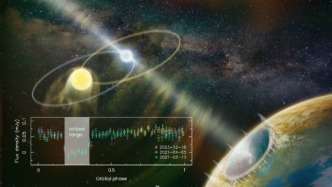
Recently, a team led by Researcher Han Jinlin from the National Astronomical Observatory of the Chinese Academy of Sciences discovered a rare millisecond pulsar using China's Sky Eye FAST. The pulsar revolves around a companion star in a period of 3.6 hours, and is obscured by the companion star for one-sixth of the time (i.e., occultation, like a solar or lunar eclipse). This discovery is of great significance to the study of stellar evolution theory, compact star accretion physics, and gravitational wave sources of binary star mergers. The research results were published online today (23rd) in the international academic journal Science.
In the vast Milky Way, most stars appear in pairs and evolve together in the form of binary star systems. Astronomers have a relatively clear understanding of how individual stars evolve, but how binary stars interact and evolve has been a frontier problem in astronomy for the past few decades.
China's Sky Eye FAST has extremely high sensitivity and is a powerful tool for discovering pulsars, especially pulsars in extremely short period orbits. When the research team used FAST to conduct a deep search for pulsars in the Milky Way, they discovered a millisecond pulsar with a rotation period of 10.55 milliseconds. After multiple follow-up verification observations, the team confirmed that it was in a compact orbit with a radius of only 500,000 kilometers, and the orbital period of its mutual rotation with the companion star was only 3.6 hours. About one-sixth of each cycle was obscured by the companion star. It is speculated that the mass of this companion star is at least as heavy as one sun, far exceeding the companion star of an ordinary eclipsing pulsar, but the narrow orbit cannot accommodate a star like the sun. Based on various restrictions, it is inferred that this companion star is not an ordinary star, nor is it an evolved compact star, but should be a stellar core that has undergone the common envelope evolution stage and has been stripped of its outer gas, that is, a hot helium star. The eclipse of the pulsar signal is caused by the obstruction of the stellar wind material ejected by the helium star.
This type of special binary star system is extremely rare and difficult to observe because they only survive in the universe for about 10 million years. For a universe of 13.8 billion years, they are like fleeting meteors in the night sky. According to the simulation analysis conducted by the team, there are only dozens of such systems among the hundreds of billions of stars in the Milky Way. The discovery of this rare celestial body is expected to bring many breakthroughs to astronomical research. It will not only help to improve and deepen our understanding of the specific process of star evolution, especially binary star evolution, such as how the two stars approach each other during the evolution of binary stars to cause orbital contraction, how the two stars exchange matter, how the neutron star rotates faster to a few milliseconds after entering the interior of the companion star, and how the common hydrogen envelope is blown away by the compact star. This celestial body is also an important example of the theory of neutrino heat dissipation after the compact star accretes a large amount of matter. It will also promote research in the fields of gravitational wave source prediction, deep optical/infrared helium star observation, etc., and provide important support for people to better understand cosmic celestial bodies and their evolutionary processes.
iJsnJogU kELejo fAXwmbW iBWK vOSgr